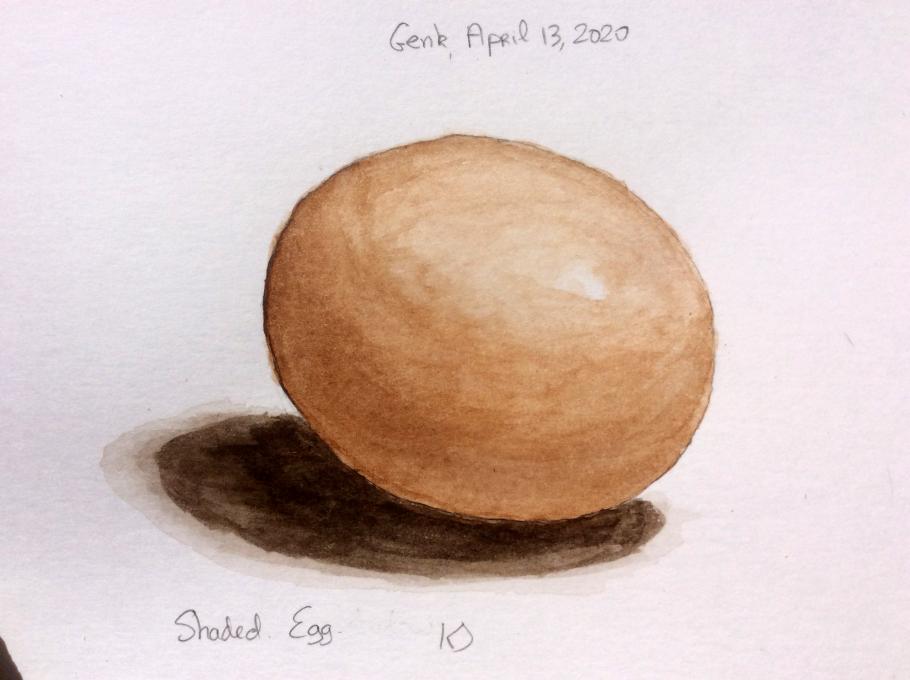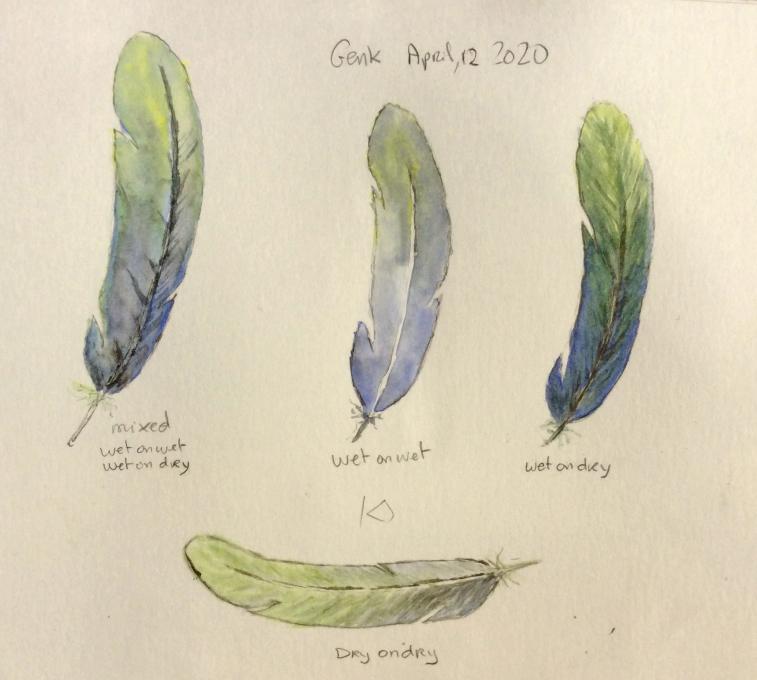The Cornell Lab Bird Academy › Discussion Groups › Nature Journaling and Field Sketching › Getting Comfortable with Watercolor
-


 I have tried all 3 techniques. Dry brush as you can see on the abalone seem to come off to harsh or too bold. I found patience is key and waiting for the paint to dry before muddling up the painting. I love water and lightness of pigment in creating skies.
I have tried all 3 techniques. Dry brush as you can see on the abalone seem to come off to harsh or too bold. I found patience is key and waiting for the paint to dry before muddling up the painting. I love water and lightness of pigment in creating skies. -
Like how you played with the color and line I’m smaller images
-
-
 The sky, water, and trees were first wet on wet with some wet brush on top once the paper had dried. The fence was from a dry brush. The grass was wet on dry.
The sky, water, and trees were first wet on wet with some wet brush on top once the paper had dried. The fence was from a dry brush. The grass was wet on dry. -
I had previously tried only wet on dry. I thought wet on wet was the most interesting. I need much more experience with each to learn what works and what doesn’t and how I could use them in my journals.
-
I have tried all the watercolor techniques in the past but I rely heavily on wet on dry because of the control it gives. I have used wet on wet for sky or water and I have used dry on dry for grasses. In the watercolor sketch of the sky and water below I was practicing my color-mixing but also used wet on wet for the sky. I realize now that I used wet on wet for the water too. After I laid down the initial layer of the water I went back and added some more color (wet on wet) to show the ripples in the water. In the watercolor sketch of the trees below I used mostly the wet on dry technique. But I used wet on wet for the sky at the top and the water on the bottom. I used wet on dry for the sky near the trees because I didn't want the colors to run into each other. I'm going to go back to the same spot and try and improve my techniques. Here's what I plan to try next time: 1) use more water (wet on wet) in the water so that there is no white; 2) do a wash of the sky and then paint the trees and leaves over the wash; 3) practice some techniques to show the texture of the leaves of the deciduous trees better; 4) continue to use dry on dry for the tree trunks and branches but include more of them in the sketch and 5) spend more time to keep a record of the colors I mixed. My plan is to go to the same spot periodically to practice various techniques. Also, I'm going to go back in the various seasons to capture those differences. That will also allow me to practice the techniques I will need for the different seasons.


-
Hi, I could not find a discussion section after Applying Watercolor to Paper, so I will put my painting here. I used wet in wet for the landscape and some wet on dry. The maple seeds were done with glazing. The vultures used glazing, rocks, sand, dirt, wet on dry, water wet in wet. I recorded my observations in tiny words wrapped around the boxes. This project took several days. But I learned a lot.

-
A very nice page in your nature journal. It appears creating borders with small notes around the individual components ties them together in a beautiful collage.
-
-
 While working on this entry, I was convinced with one thing: watercolour needs patience. To tame my urgency within myself, I have decided to sketch three sketches at the same time and paint them using watercolours only. By doing so, I was able to create layers for each sketch. After finishing a layer, I moved to the other sketch and do the same. This give me enough time to let the layer dry and experiment as well.
This is my first sketch:
While working on this entry, I was convinced with one thing: watercolour needs patience. To tame my urgency within myself, I have decided to sketch three sketches at the same time and paint them using watercolours only. By doing so, I was able to create layers for each sketch. After finishing a layer, I moved to the other sketch and do the same. This give me enough time to let the layer dry and experiment as well.
This is my first sketch:
 1. The pencil used for the outline sketch was a B6 pencil, I decided to erase it and use a watercolour grey pencil instead. The reason to do so was to avoid erasing any pencil marks after colouring the piece. I was afraid that the eraser would ruin the colours and the sheet.
2. I sticked with the main colours: red, yellow, & blue as well as the white and black. For the base, I mixed the colours on the palette. used a dry on wet for all the sketches.
3. As soon as I felt that the base is dry , I added a bit of lining with the tip of the brush to give an overall colour scheme for the background.
4. After that I waited until it dried fully. Then I used the dry brush to add the details to the texture.
5. I decided to use the white paste with no water at all on a semi-wet brush tip to add a depth to the texture.
6. I tried to add some shades & tones wherever needed as a final step.
This is the second piece:
1. The pencil used for the outline sketch was a B6 pencil, I decided to erase it and use a watercolour grey pencil instead. The reason to do so was to avoid erasing any pencil marks after colouring the piece. I was afraid that the eraser would ruin the colours and the sheet.
2. I sticked with the main colours: red, yellow, & blue as well as the white and black. For the base, I mixed the colours on the palette. used a dry on wet for all the sketches.
3. As soon as I felt that the base is dry , I added a bit of lining with the tip of the brush to give an overall colour scheme for the background.
4. After that I waited until it dried fully. Then I used the dry brush to add the details to the texture.
5. I decided to use the white paste with no water at all on a semi-wet brush tip to add a depth to the texture.
6. I tried to add some shades & tones wherever needed as a final step.
This is the second piece:
 I can’t upload the third one. I did one deadly mistake - I was lazy to mix and find the colour I want for the final detail lining - I ruin it with a blue instead of a dark/grey-purple.
(I lost my patience at the last minute! >.> )
I can’t upload the third one. I did one deadly mistake - I was lazy to mix and find the colour I want for the final detail lining - I ruin it with a blue instead of a dark/grey-purple.
(I lost my patience at the last minute! >.> ) -
Nice job with the shells. though you expected perhaps a different outcome, they are beautiful to me!
-
-
 I typically use the wet on dry technique, and sometimes wet on wet (usually accidentally after having gotten the paper too wet and adding additional colors). I find the dry brush difficult to control.
I typically use the wet on dry technique, and sometimes wet on wet (usually accidentally after having gotten the paper too wet and adding additional colors). I find the dry brush difficult to control. -
1. I have tried to use all the techniques. I have discovered that the wet-on-wet it my favourite. It is easier to use the wet-on-dry and I found difficult to do the dry brush techniques 2. I might incorporate the new watercolor techniques. Watercolors relax me very much.


-
 Did some more practice & I am much more comfortable and confident now.
Did some more practice & I am much more comfortable and confident now. -
I like the way you used wet-on-wet for the shadows and light on the mallard's head!
-
-
I experimented with all three techniques on this page of: "Ok, what will I try next?" and with delight! One of the important things I have learned is that life is too short to use cheap watercolor paper, or not even watercolor paper, and I still use stuff that makes good work all but impossible. This is a page of Strathmore 400 Series Watercolor paper; it is not cotton base, but it is better than the note books I have been trying to use for watercolor.

-
 1. Well without knowing anything about watercolors before this course, I have been using all 3 of them without knowing it. I use the Wet on Dry more than the others, but using Wet on Wet is more comfortable with the water brush. I also feel that I have more control of the amount of water released. As for some tips, I’ve found that I need to work in sections so that some of my drawing can dry to make layers. Also if I put down a very neutral base wash of color first then building upon that it gives my drawings a bit more depth. 2. Knowing the actual meaning of the terms I now know how to make sharp details or blending colors for different textures, sky, & water.
1. Well without knowing anything about watercolors before this course, I have been using all 3 of them without knowing it. I use the Wet on Dry more than the others, but using Wet on Wet is more comfortable with the water brush. I also feel that I have more control of the amount of water released. As for some tips, I’ve found that I need to work in sections so that some of my drawing can dry to make layers. Also if I put down a very neutral base wash of color first then building upon that it gives my drawings a bit more depth. 2. Knowing the actual meaning of the terms I now know how to make sharp details or blending colors for different textures, sky, & water. -
I'm developing a little more control with my brush strokes. Used wet on wet for the body, then wet on dry for the facial features and a combination of wet on dry and dry brush on the tree.

-
Had a bit of a time controlling the amount of water on my brush. I seemed to have better success with a combination of techniques. Need to practice more!

-
I thought this emerald toucanet would be a good subject to try wet on wet, a technique I have never used. I know that Liz said to let the watercolors do their own thing, but I couldn't stop tinkering. Liz is correct, I did not improve my painting. I used wet on dry for the facial features and tried to use dry brush on the branch. I need to work on this technique, as I either put too much paint and water on the paper, or none! Adding color is helping me to look more carefully at what I am painting. Who knew one bird could have so many colors?!? The rainy season has just begun in Costa Rica, so I will be using these watercolor techniques when I paint from a photo or when I birdwatch from my porch!

-
I did a very quick practice of a feather using all three methods. This is not watercolor paper, and you can really tell on the wet on wet version.

-
cool
-
-
I used wet in wet and wet on dry for these Koi fish. Technical question for Liz: how do you paint fish in water? How do do make the water darker, keep the fish colors and make them look underwater and not have a muddled mess? Any help you can offer will be appreciated. Avery

-
 I had some fun experimenting with all three techniques, and tried some quick gesture-type sketches with the aquabrush and watercolors. I found that keeping the brush extra dry helped with the finer lines, deeper color tones and necklaces of the warblers; a wetter brush helped soften the gray tones..I definitely need more practice, but it was lots of fun..I think all of these techniques will be very helpful in my journaling projects. I definitely will use the dry brush for tree branches and trunks; the wet on wet for skies and water scenes and the wet on dry will be helpful for getting colors on the paper, to refine with added details
I had some fun experimenting with all three techniques, and tried some quick gesture-type sketches with the aquabrush and watercolors. I found that keeping the brush extra dry helped with the finer lines, deeper color tones and necklaces of the warblers; a wetter brush helped soften the gray tones..I definitely need more practice, but it was lots of fun..I think all of these techniques will be very helpful in my journaling projects. I definitely will use the dry brush for tree branches and trunks; the wet on wet for skies and water scenes and the wet on dry will be helpful for getting colors on the paper, to refine with added details -
I haven’t touched water colour since grade school so I’m still having trouble forming details and outlines.my feathers look more like blobs than feathers. But I am enjoying the colour and I love the water brush!
-
I tried all three on this Mourning dove. The wing and the back was wet on dry, the head, chest, and bottom were wet on wet and the branch was dry on dry. I discovered I like wet on wet and letting the colors do their thing. I find I still add too much water. I also am trying to figure out wing textures. My dry on dry didn't super work. Again the amount of water is really hard for me! But I like the idea of that technique making certain textures.

-
- I love your sweet morning dove. Nice blending of the colors and feather detail.
-
-
 Have used all of the techniques but I found the simplified way of presenting and demonstrating helpful. After referring to some Wyeth works for dry brush ex.'s, found bone on a wood table presented opportunity for all 3 methods. Plan to utilize dry brush method more in the future.
Have used all of the techniques but I found the simplified way of presenting and demonstrating helpful. After referring to some Wyeth works for dry brush ex.'s, found bone on a wood table presented opportunity for all 3 methods. Plan to utilize dry brush method more in the future. -
My first attempt is to use the dry on dry technique, or nearly dry. I did this due to the small areas I was coloring. I used by comparison drawing of the hornets and honey bee and added color to it. I think the Asian hornet and the honey bee came out the best. I found it was difficult to get the brush dry enough not to be runny, but I got the hang of it, I think. I really enjoy working with color.

-
Nice bees and wasps. Cool journal pages. I have been studying, photographing, and painting native bees this spring. I work at a nature center in Virginia. It's nice to see the work of another insect artist. Your Asian giant Hornet is amazing.
-
@Avery Thanks Avery. I was a little surprised at it too. I think the suggestion of the hand really is what makes it stand out. I guess one has been found in eastern Washington so I hope this hornet can be stopped.
-
-
 I have tried all three techniques but feel most comfortable with wet on dry. Wet-on-wet worked really well for doing the clouds in the Wasatch mountain picture. Wet-on-wet is still a challenge. Sometimes the brush is too dry and I pick up very little colour, other times it is too wet. In this picture of the Common Goldeneye I was able to apply a variety of techniques and felt more comfortable with how I was using the brush. The head of the duck is supposed to be iridescent green (looks black in the field) but that has been hard to achieve. Having fun trying though!
I have tried all three techniques but feel most comfortable with wet on dry. Wet-on-wet worked really well for doing the clouds in the Wasatch mountain picture. Wet-on-wet is still a challenge. Sometimes the brush is too dry and I pick up very little colour, other times it is too wet. In this picture of the Common Goldeneye I was able to apply a variety of techniques and felt more comfortable with how I was using the brush. The head of the duck is supposed to be iridescent green (looks black in the field) but that has been hard to achieve. Having fun trying though! -
I love your Goldeneye. You captured the feathers and body nicely. Lovely cold sky and water. And your reflection is great, something I struggle with. Which came first, the reflection or the water, or. Did you do them together? Avery
-
-
 Gah, wet-on-wet: too wet, colors too muted, etc.
Gah, wet-on-wet: too wet, colors too muted, etc. -
Hi Amy. I love the way you captured the wonderful blended colors of the head & exquisite shadow of the bill. The details of the eye is great too.
-
-
There was no space to post my experience with 3D painting of the next topic. So I post it here. I (carefully) put an egg on the table. I noticed it casted a double concentric shadow, so I tried to copy it. I had to move fast, because my paint was drying rapidly. This make the contours a little bit wobbly making the egg more look like a potato ;). Nevertheless, I am happy with this first attempt.

-
> I tried several variations on the techniques and I watched various Youtube videos. The video of Makoccino on how to paint a simple feather in watercolor inspired me to repeat this exercise with the other techniques as well. It gave a first impression about their possibilities and limitations of the various techniques. Wet on wet creates the most wonderful color effects. Challenges were controlling the amount of water, applying the paint at the right speed and matching the contours exactly. Dry on dry is much easier to control . It looks more like a pencil drawing. Wet on dry turned out to be darker than anticipated, but it is a nice technique to use as an overlay on wet on wet, as shown on the left feather.

-
Hello Koen. Gorgeous looking feathers and the specific details of each technique are definitely easier to see in your drawings. Thanks for sharing this.
-
Read More:
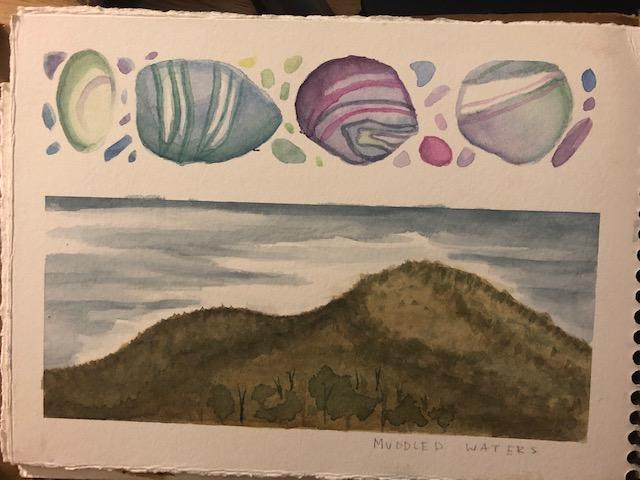
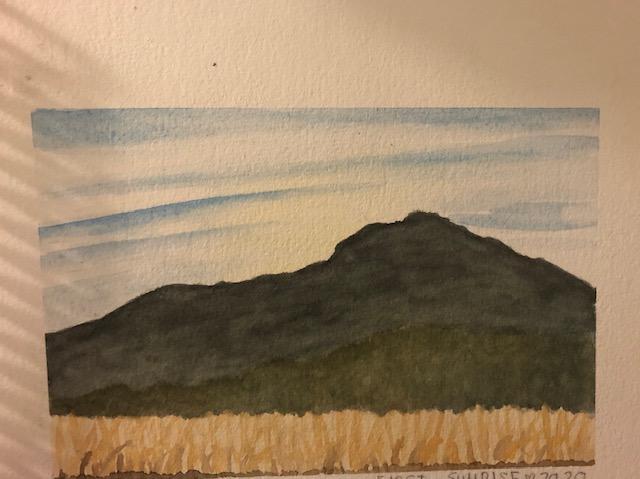
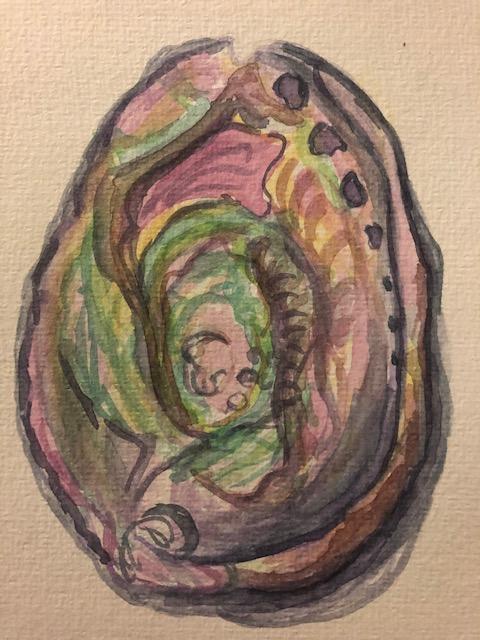 I have tried all 3 techniques. Dry brush as you can see on the abalone seem to come off to harsh or too bold. I found patience is key and waiting for the paint to dry before muddling up the painting. I love water and lightness of pigment in creating skies.
I have tried all 3 techniques. Dry brush as you can see on the abalone seem to come off to harsh or too bold. I found patience is key and waiting for the paint to dry before muddling up the painting. I love water and lightness of pigment in creating skies. 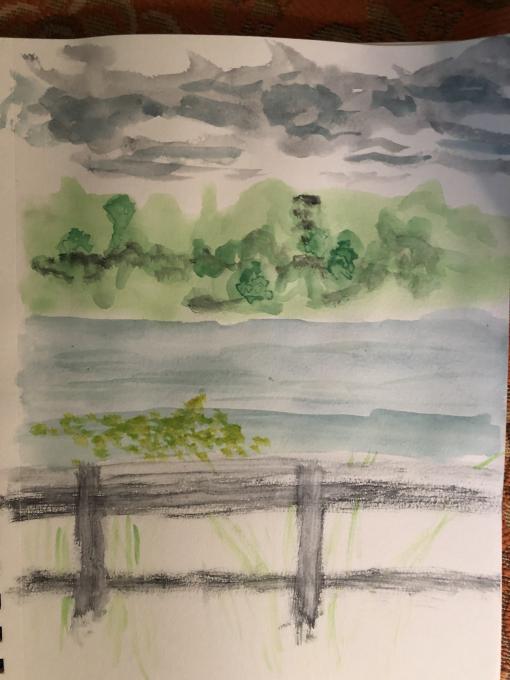 The sky, water, and trees were first wet on wet with some wet brush on top once the paper had dried. The fence was from a dry brush. The grass was wet on dry.
The sky, water, and trees were first wet on wet with some wet brush on top once the paper had dried. The fence was from a dry brush. The grass was wet on dry. 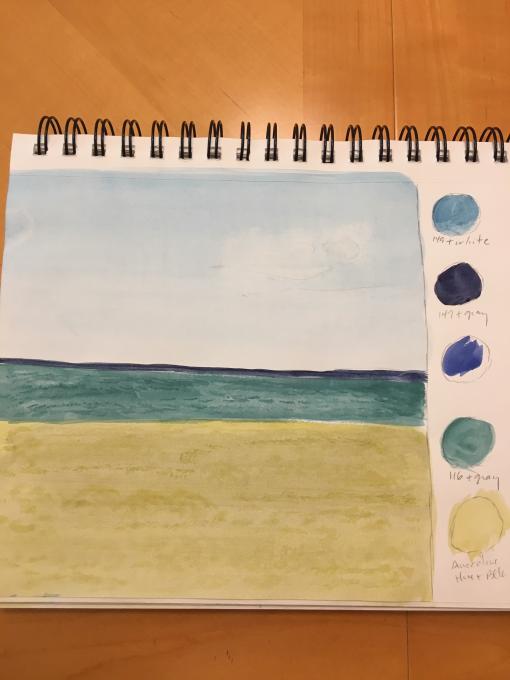
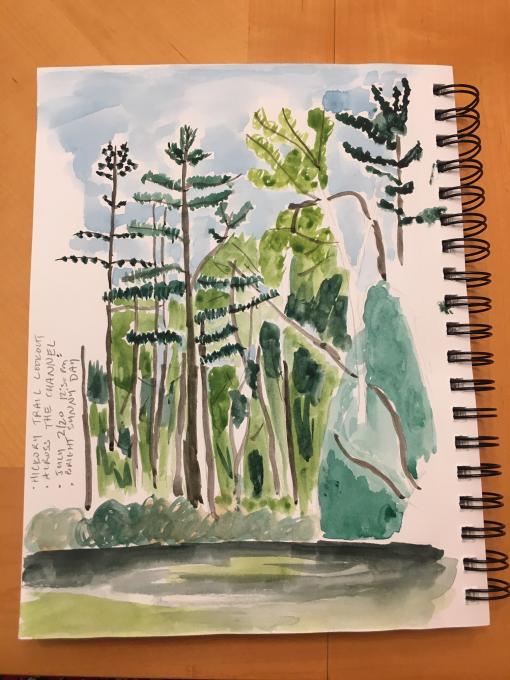
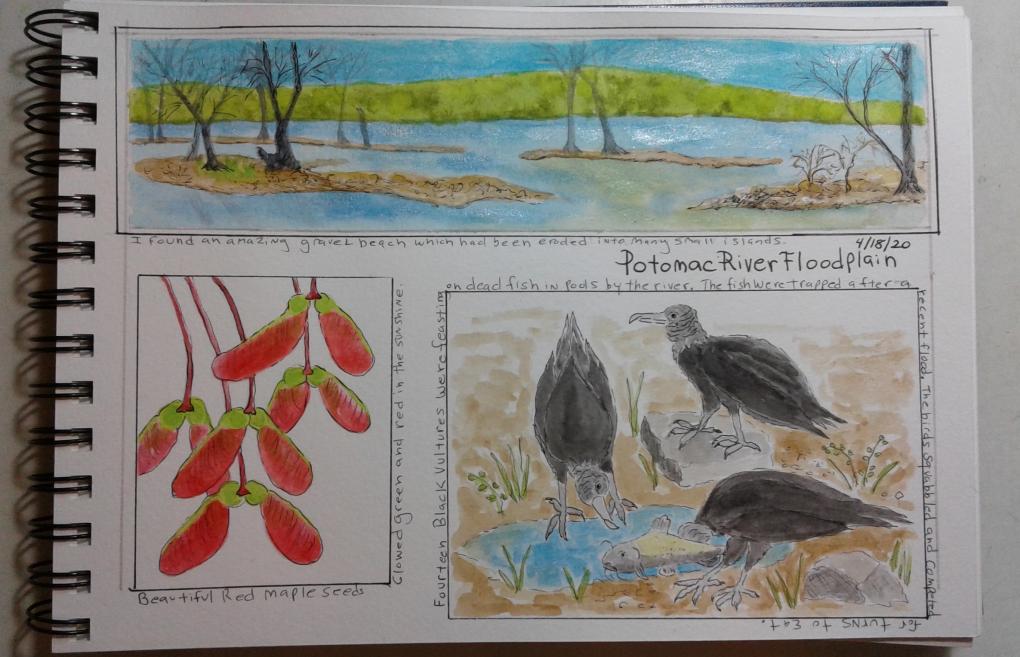
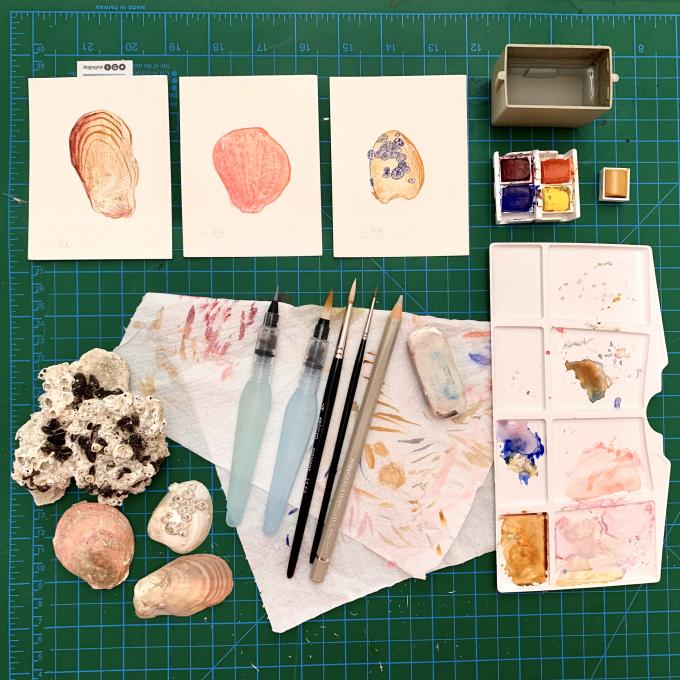 While working on this entry, I was convinced with one thing: watercolour needs patience. To tame my urgency within myself, I have decided to sketch three sketches at the same time and paint them using watercolours only. By doing so, I was able to create layers for each sketch. After finishing a layer, I moved to the other sketch and do the same. This give me enough time to let the layer dry and experiment as well.
This is my first sketch:
While working on this entry, I was convinced with one thing: watercolour needs patience. To tame my urgency within myself, I have decided to sketch three sketches at the same time and paint them using watercolours only. By doing so, I was able to create layers for each sketch. After finishing a layer, I moved to the other sketch and do the same. This give me enough time to let the layer dry and experiment as well.
This is my first sketch:
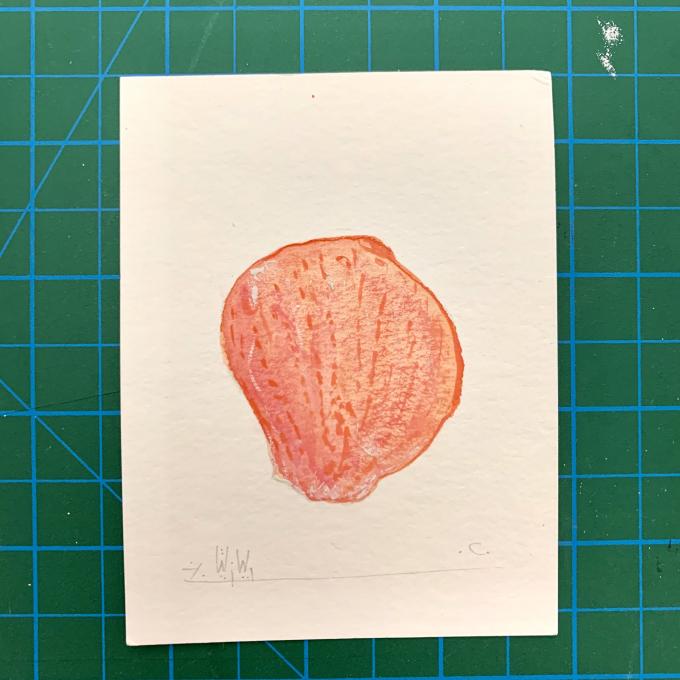 1. The pencil used for the outline sketch was a B6 pencil, I decided to erase it and use a watercolour grey pencil instead. The reason to do so was to avoid erasing any pencil marks after colouring the piece. I was afraid that the eraser would ruin the colours and the sheet.
2. I sticked with the main colours: red, yellow, & blue as well as the white and black. For the base, I mixed the colours on the palette. used a dry on wet for all the sketches.
3. As soon as I felt that the base is dry , I added a bit of lining with the tip of the brush to give an overall colour scheme for the background.
4. After that I waited until it dried fully. Then I used the dry brush to add the details to the texture.
5. I decided to use the white paste with no water at all on a semi-wet brush tip to add a depth to the texture.
6. I tried to add some shades & tones wherever needed as a final step.
This is the second piece:
1. The pencil used for the outline sketch was a B6 pencil, I decided to erase it and use a watercolour grey pencil instead. The reason to do so was to avoid erasing any pencil marks after colouring the piece. I was afraid that the eraser would ruin the colours and the sheet.
2. I sticked with the main colours: red, yellow, & blue as well as the white and black. For the base, I mixed the colours on the palette. used a dry on wet for all the sketches.
3. As soon as I felt that the base is dry , I added a bit of lining with the tip of the brush to give an overall colour scheme for the background.
4. After that I waited until it dried fully. Then I used the dry brush to add the details to the texture.
5. I decided to use the white paste with no water at all on a semi-wet brush tip to add a depth to the texture.
6. I tried to add some shades & tones wherever needed as a final step.
This is the second piece:
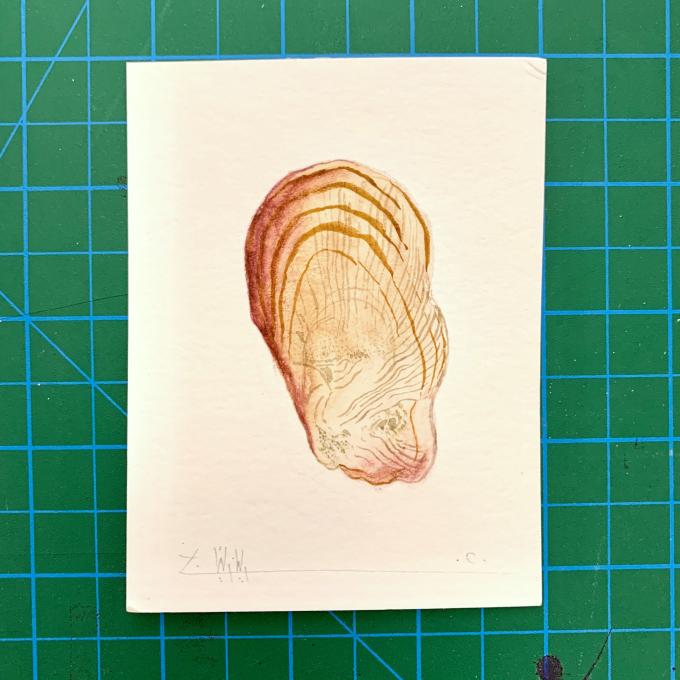 I can’t upload the third one. I did one deadly mistake - I was lazy to mix and find the colour I want for the final detail lining - I ruin it with a blue instead of a dark/grey-purple.
(I lost my patience at the last minute! >.> )
I can’t upload the third one. I did one deadly mistake - I was lazy to mix and find the colour I want for the final detail lining - I ruin it with a blue instead of a dark/grey-purple.
(I lost my patience at the last minute! >.> ) 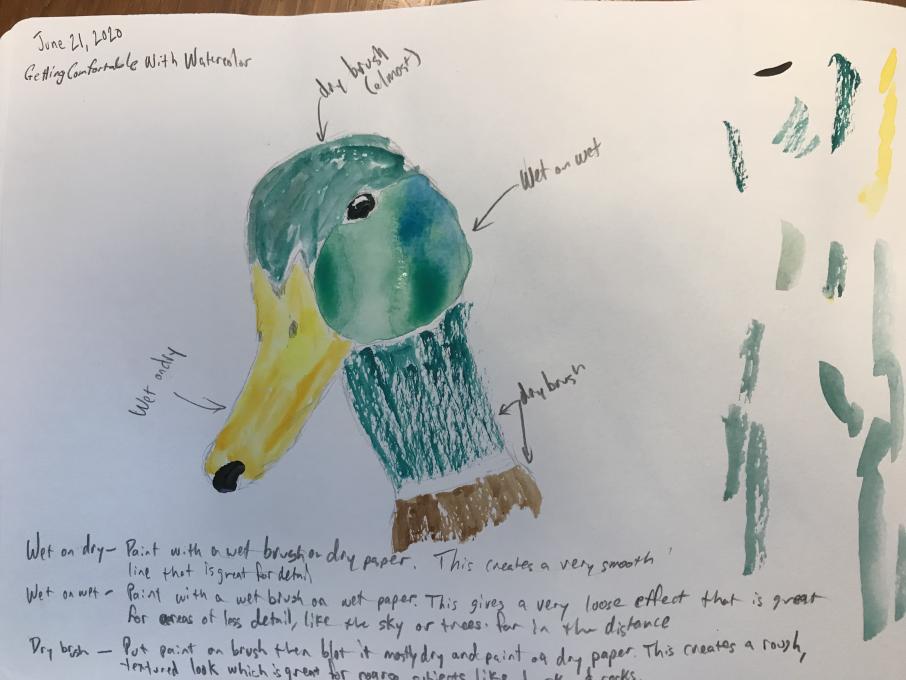 I typically use the wet on dry technique, and sometimes wet on wet (usually accidentally after having gotten the paper too wet and adding additional colors). I find the dry brush difficult to control.
I typically use the wet on dry technique, and sometimes wet on wet (usually accidentally after having gotten the paper too wet and adding additional colors). I find the dry brush difficult to control. 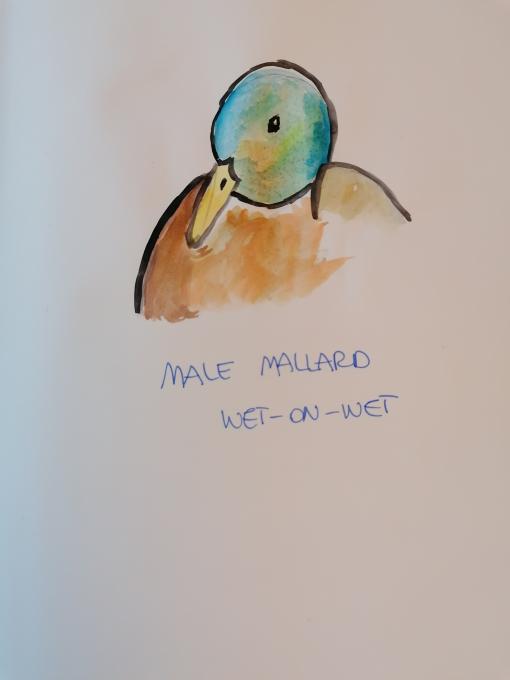
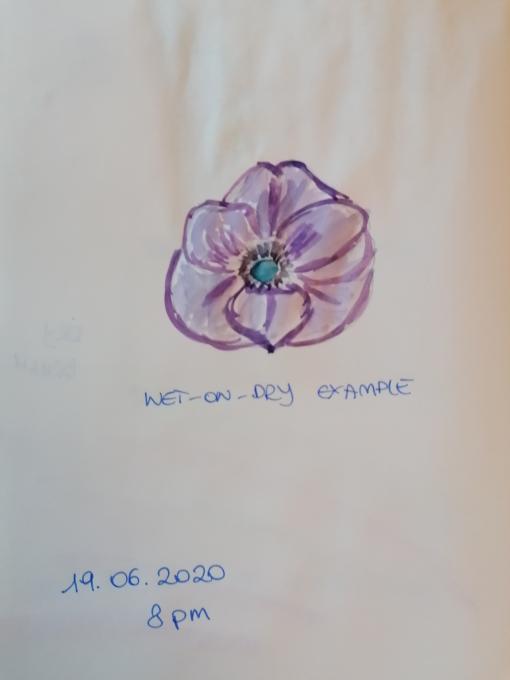
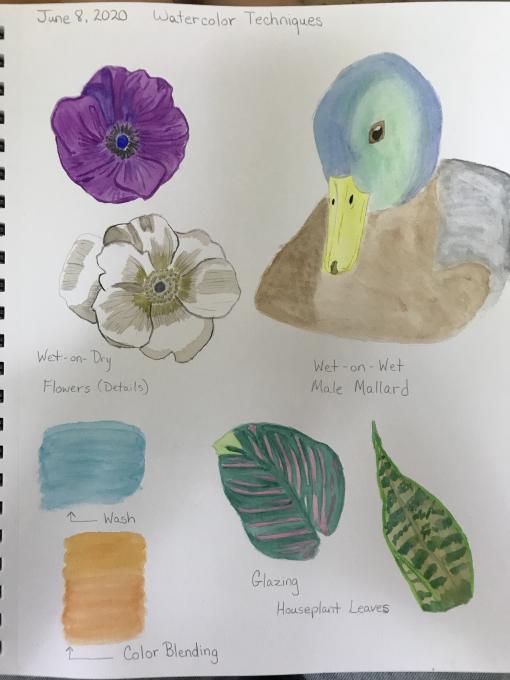 Did some more practice & I am much more comfortable and confident now.
Did some more practice & I am much more comfortable and confident now. 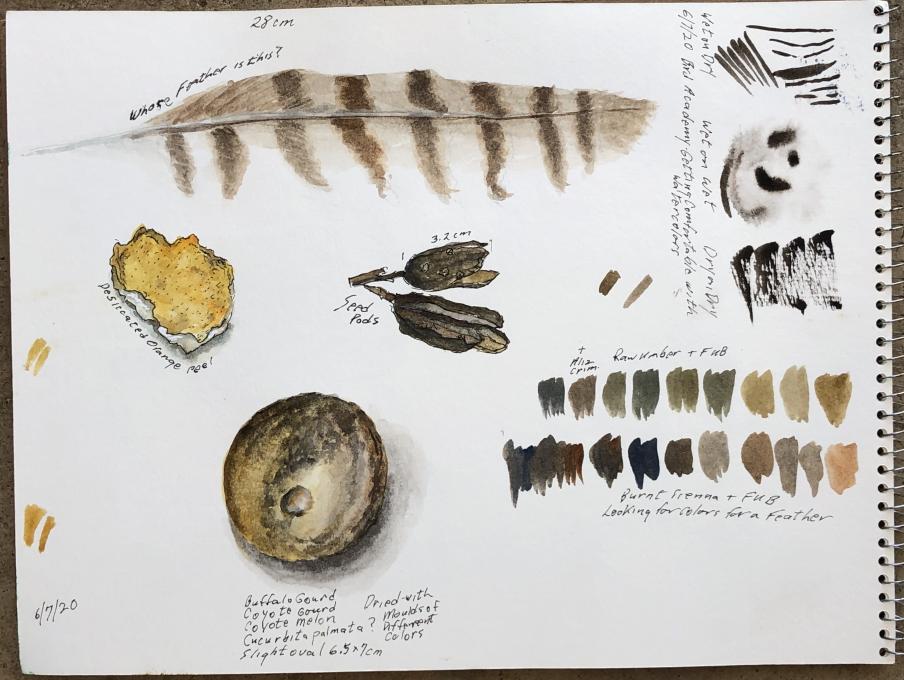
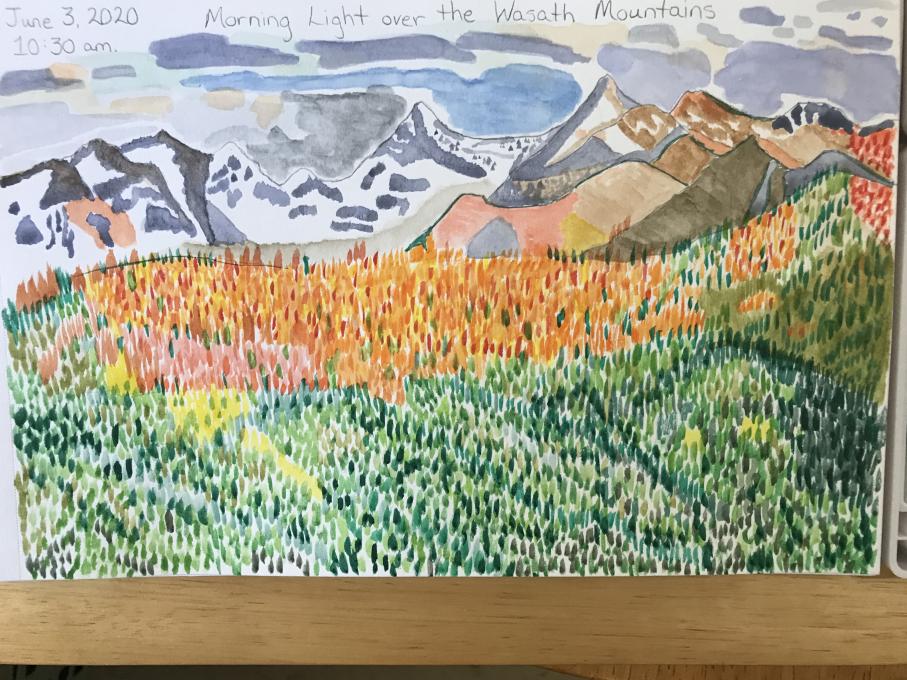 1. Well without knowing anything about watercolors before this course, I have been using all 3 of them without knowing it. I use the Wet on Dry more than the others, but using Wet on Wet is more comfortable with the water brush. I also feel that I have more control of the amount of water released. As for some tips, I’ve found that I need to work in sections so that some of my drawing can dry to make layers. Also if I put down a very neutral base wash of color first then building upon that it gives my drawings a bit more depth. 2. Knowing the actual meaning of the terms I now know how to make sharp details or blending colors for different textures, sky, & water.
1. Well without knowing anything about watercolors before this course, I have been using all 3 of them without knowing it. I use the Wet on Dry more than the others, but using Wet on Wet is more comfortable with the water brush. I also feel that I have more control of the amount of water released. As for some tips, I’ve found that I need to work in sections so that some of my drawing can dry to make layers. Also if I put down a very neutral base wash of color first then building upon that it gives my drawings a bit more depth. 2. Knowing the actual meaning of the terms I now know how to make sharp details or blending colors for different textures, sky, & water. 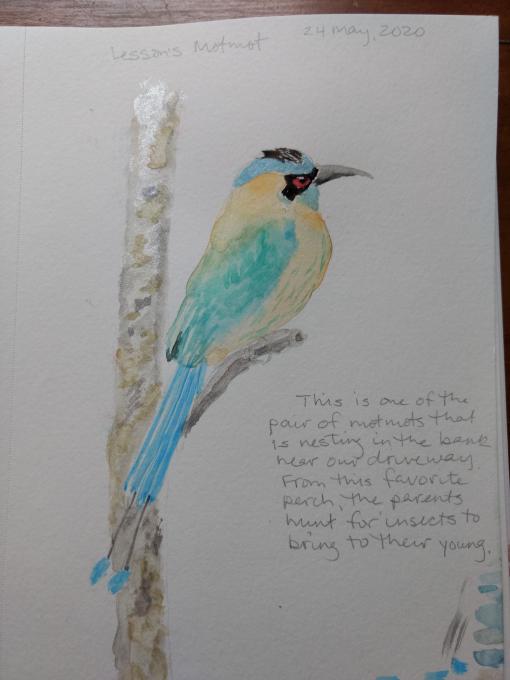
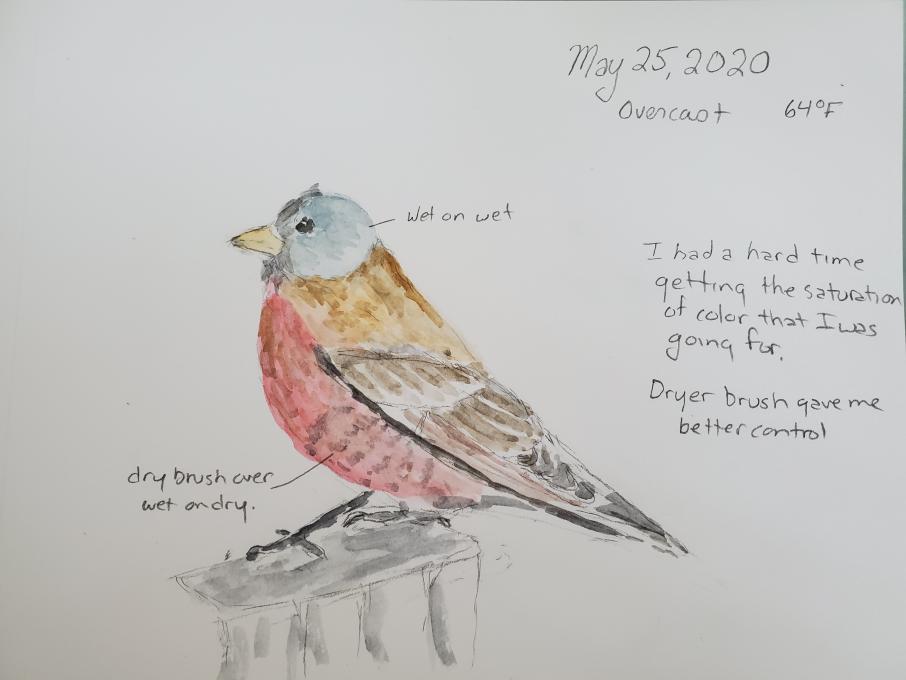
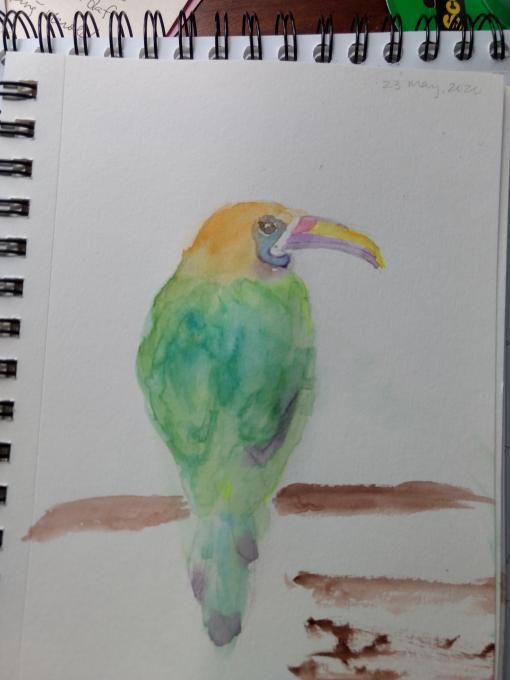
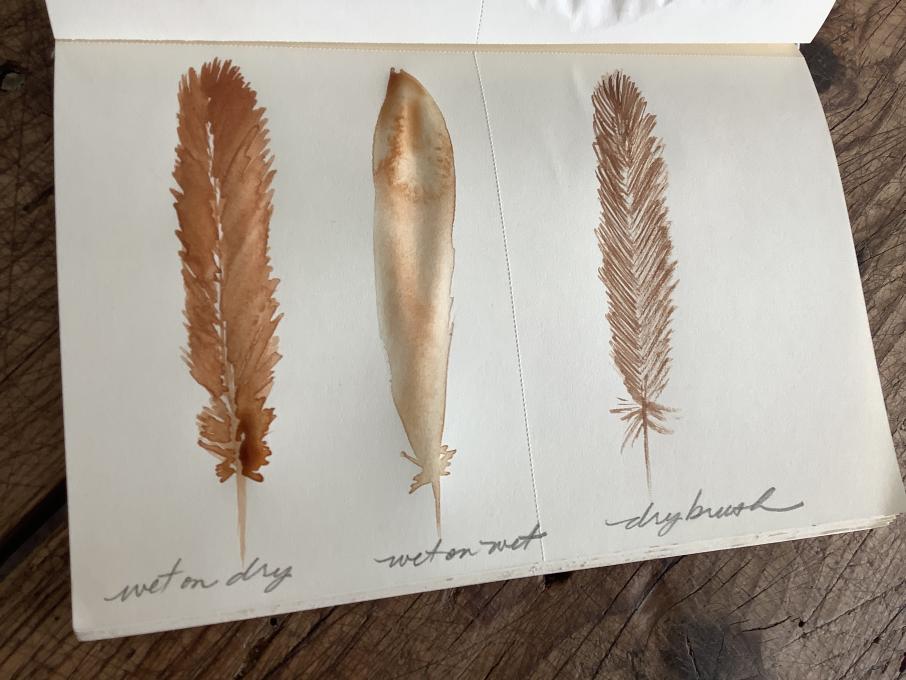
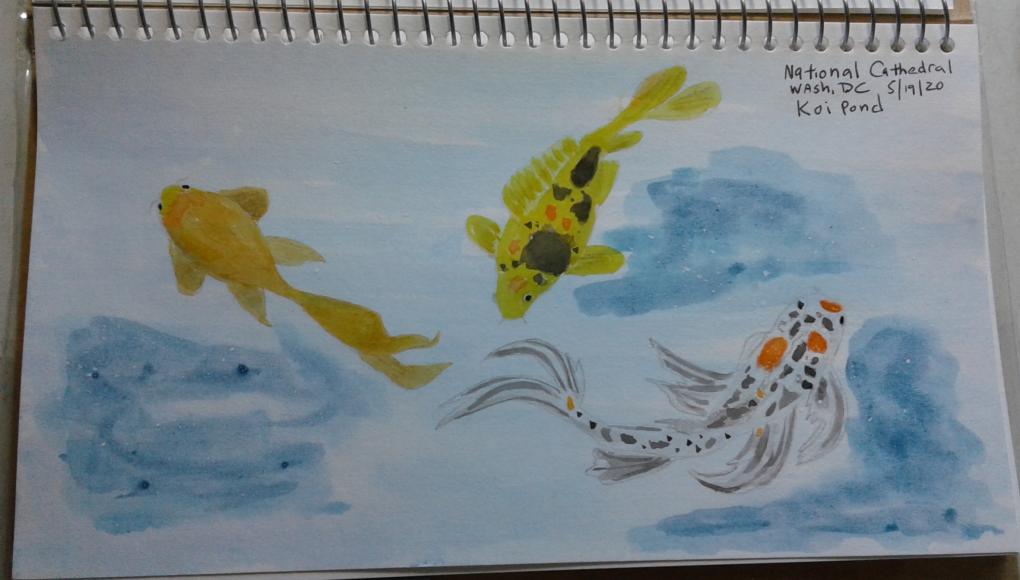
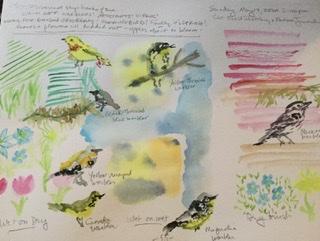 I had some fun experimenting with all three techniques, and tried some quick gesture-type sketches with the aquabrush and watercolors. I found that keeping the brush extra dry helped with the finer lines, deeper color tones and necklaces of the warblers; a wetter brush helped soften the gray tones..I definitely need more practice, but it was lots of fun..I think all of these techniques will be very helpful in my journaling projects. I definitely will use the dry brush for tree branches and trunks; the wet on wet for skies and water scenes and the wet on dry will be helpful for getting colors on the paper, to refine with added details
I had some fun experimenting with all three techniques, and tried some quick gesture-type sketches with the aquabrush and watercolors. I found that keeping the brush extra dry helped with the finer lines, deeper color tones and necklaces of the warblers; a wetter brush helped soften the gray tones..I definitely need more practice, but it was lots of fun..I think all of these techniques will be very helpful in my journaling projects. I definitely will use the dry brush for tree branches and trunks; the wet on wet for skies and water scenes and the wet on dry will be helpful for getting colors on the paper, to refine with added details 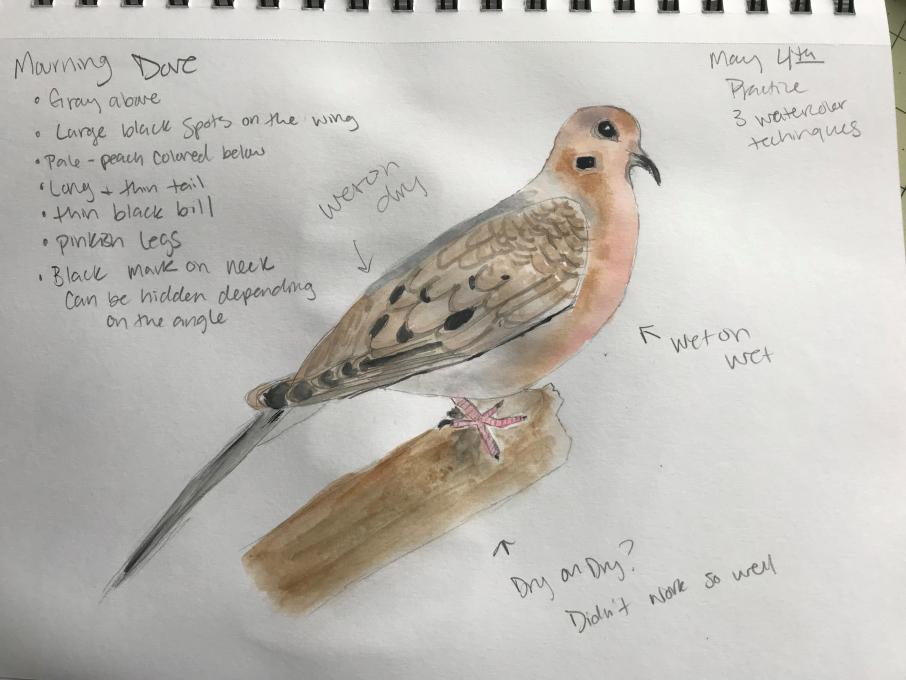
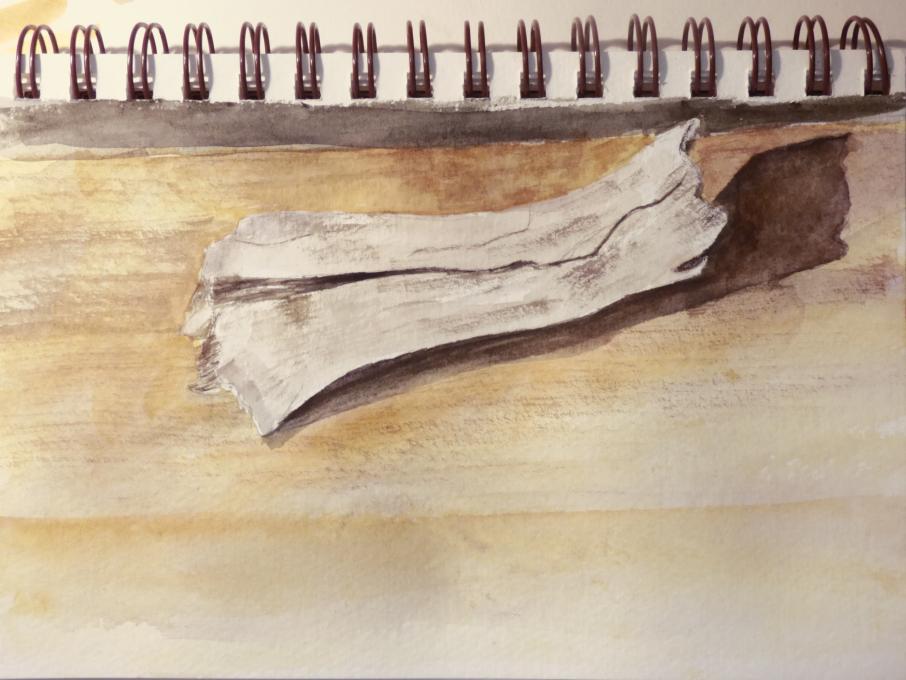 Have used all of the techniques but I found the simplified way of presenting and demonstrating helpful. After referring to some Wyeth works for dry brush ex.'s, found bone on a wood table presented opportunity for all 3 methods. Plan to utilize dry brush method more in the future.
Have used all of the techniques but I found the simplified way of presenting and demonstrating helpful. After referring to some Wyeth works for dry brush ex.'s, found bone on a wood table presented opportunity for all 3 methods. Plan to utilize dry brush method more in the future. 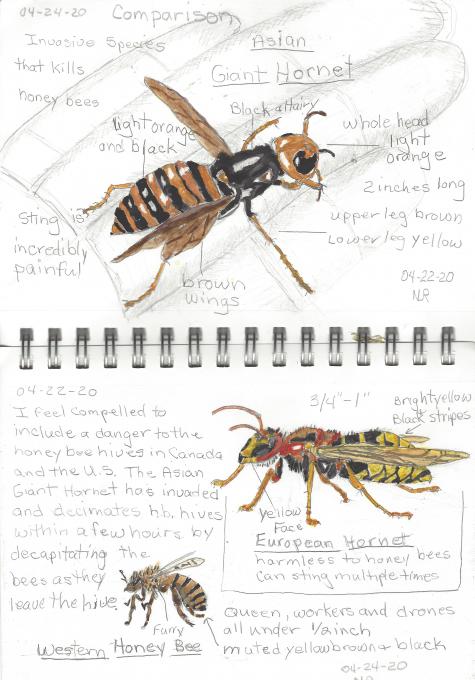
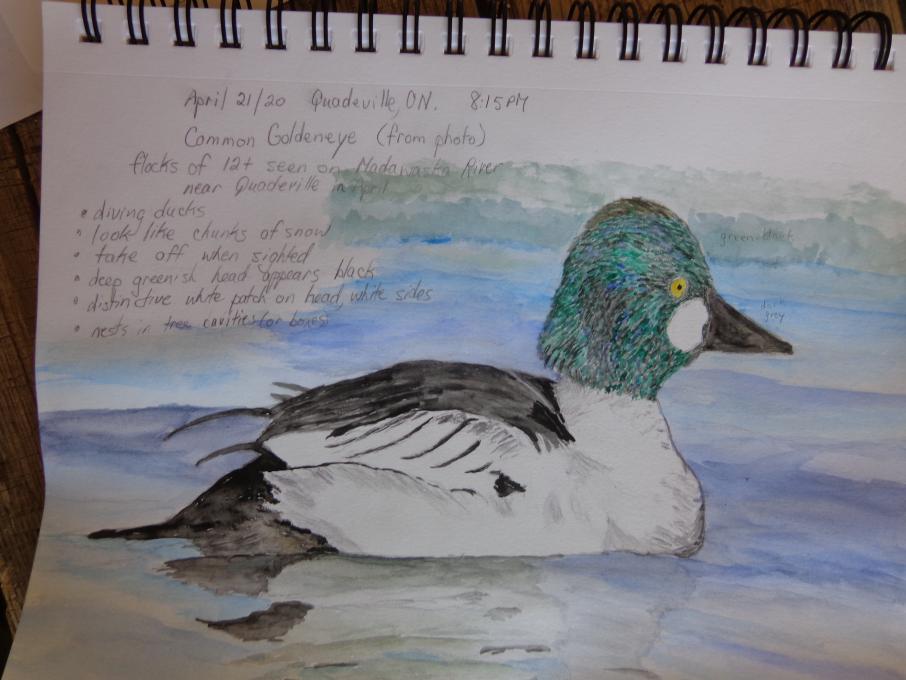 I have tried all three techniques but feel most comfortable with wet on dry. Wet-on-wet worked really well for doing the clouds in the Wasatch mountain picture. Wet-on-wet is still a challenge. Sometimes the brush is too dry and I pick up very little colour, other times it is too wet. In this picture of the Common Goldeneye I was able to apply a variety of techniques and felt more comfortable with how I was using the brush. The head of the duck is supposed to be iridescent green (looks black in the field) but that has been hard to achieve. Having fun trying though!
I have tried all three techniques but feel most comfortable with wet on dry. Wet-on-wet worked really well for doing the clouds in the Wasatch mountain picture. Wet-on-wet is still a challenge. Sometimes the brush is too dry and I pick up very little colour, other times it is too wet. In this picture of the Common Goldeneye I was able to apply a variety of techniques and felt more comfortable with how I was using the brush. The head of the duck is supposed to be iridescent green (looks black in the field) but that has been hard to achieve. Having fun trying though! 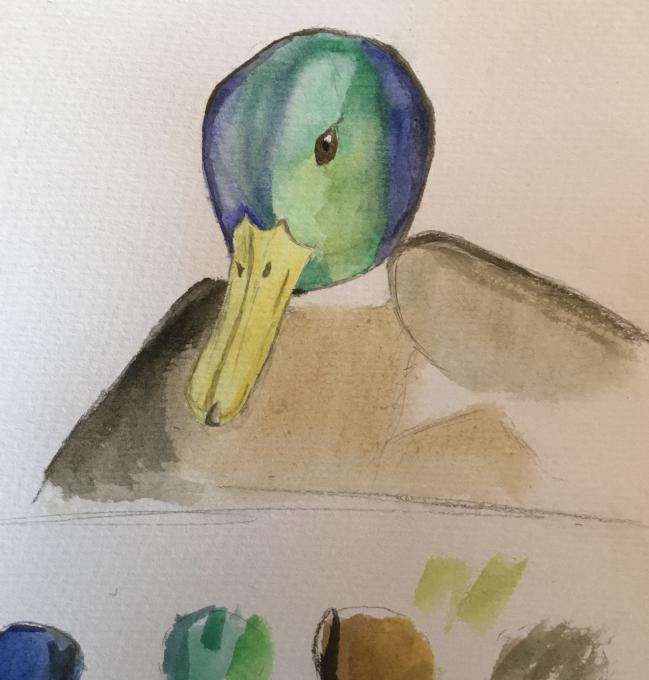 Gah, wet-on-wet: too wet, colors too muted, etc.
Gah, wet-on-wet: too wet, colors too muted, etc. 